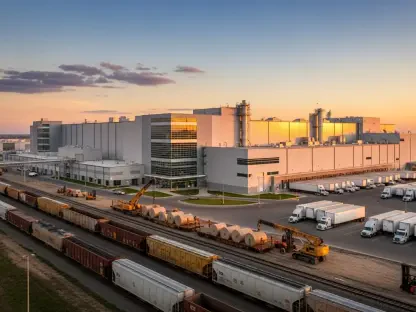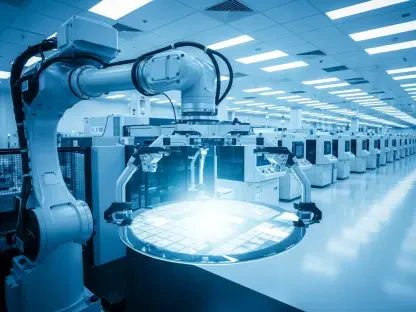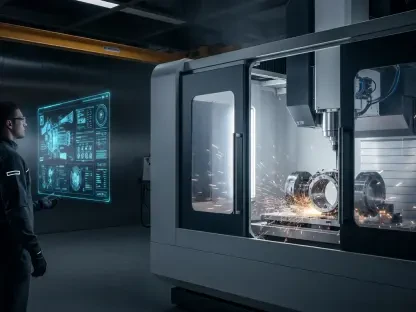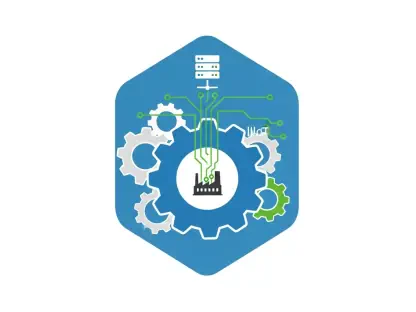Setting the Stage for Digital Defense
In an era where manufacturing plants are more connected than ever, a single cyberattack can halt production lines, costing millions in mere hours, and the impact can be devastating. Imagine a scenario where a ransomware attack locks down a major automotive manufacturer’s systems, disrupting not just one facility but an entire global supply chain. With the industry facing nearly 25 percent of all reported cyber incidents and an average data breach cost of $5.56 million in 2024, the stakes have never been higher. This pressing reality underscores the urgent need for robust cybersecurity solutions tailored to the unique challenges of manufacturing environments.
The rapid adoption of digital technologies, from cloud computing to automation, has transformed how manufacturers operate, promising efficiency and innovation. However, this digital shift also exposes vulnerabilities that cybercriminals are eager to exploit, targeting intellectual property, operational uptime, and customer trust. This review delves into the critical role of cybersecurity technologies in safeguarding the manufacturing sector, evaluating their features and effectiveness in combating evolving threats.
Analyzing Core Features of Cybersecurity Technologies
Cloud and IoT Security Capabilities
Cloud computing and the Internet of Things (IoT) have redefined manufacturing by enabling real-time data sharing and streamlined workflows across facilities. These technologies facilitate faster production cycles and improved resource allocation, but they also expand the attack surface with countless connected devices and distributed environments. Modern cybersecurity solutions for manufacturing must offer comprehensive protection across hybrid and multi-cloud setups, ensuring visibility and control over sprawling networks.
A key feature of effective cybersecurity tools in this space is their ability to integrate seamlessly with existing infrastructures, providing unified security policies for both on-premises and cloud-based systems. Advanced solutions employ automated threat detection and risk assessment to identify vulnerabilities before they can be exploited. Such capabilities are essential for manufacturers managing thousands of endpoints, where a single weak link could compromise the entire operation.
Beyond integration, scalability stands out as a critical performance metric. Top-tier cybersecurity platforms can adapt to the growing complexity of IoT ecosystems, enforcing consistent protection as manufacturers expand their digital footprint. This adaptability ensures that security measures remain robust even as new technologies are adopted, preventing gaps that could invite cyberattacks.
AI and Machine Learning Enhancements
Artificial Intelligence (AI) and machine learning are increasingly embedded in cybersecurity tools, offering predictive insights and real-time threat mitigation for manufacturing processes. These technologies analyze vast amounts of data to detect anomalies, such as unusual network traffic that might signal a breach, and enable proactive responses to potential threats. Their role in predictive maintenance also extends to security, identifying system weaknesses before they become exploitable.
However, securing AI-driven systems presents unique challenges, as algorithms themselves can be targeted for manipulation or data poisoning. Leading cybersecurity solutions address this by incorporating safeguards like encryption and access controls specifically designed for AI models. Performance-wise, these tools must balance speed with accuracy, ensuring that automated responses do not disrupt legitimate operations while effectively countering malicious activities.
The strength of AI and machine learning in cybersecurity lies in their ability to evolve alongside threats, learning from each incident to improve future defenses. For manufacturers, this means fewer false positives and a more reliable shield against sophisticated attacks. Solutions that prioritize continuous learning and adaptability are best positioned to protect automated production lines from emerging risks.
Performance Under Pressure: Real-World Applications
Safeguarding Operations and Supply Chains
Cybersecurity technologies in manufacturing prove their worth by protecting critical areas such as production uptime and supply chain integrity. Robust systems prevent disruptions from ransomware, which has inflicted billions in losses on the industry, with daily downtime costs averaging $1.9 million. By deploying endpoint protection and network monitoring, these tools maintain operational continuity even under attack, preserving both revenue and reputation.
Moreover, intellectual property—a cornerstone of competitive advantage—remains secure through advanced encryption and access management features. High-performing cybersecurity platforms detect unauthorized access attempts in real time, thwarting efforts to steal proprietary designs or customer data. This protection extends trust to clients and partners, reinforcing business relationships in a highly interconnected sector.
The ripple effects of a breach often span beyond a single company, impacting entire supply chains. Effective cybersecurity solutions mitigate this risk by offering collaborative security frameworks that ensure consistent protection across vendors and partners. Their performance in real-world scenarios demonstrates a capacity to limit damage, maintaining stability in ecosystems where a single failure can cascade into widespread disruption.
Challenges in Implementation and Scale
Despite their strengths, cybersecurity technologies face significant hurdles in manufacturing environments, particularly in managing security at scale. With thousands of endpoints and distributed cloud systems to secure, even the most advanced tools can struggle to maintain uniform coverage. Performance often hinges on the ability to automate policy enforcement, a feature that varies widely among available solutions.
Another limitation lies in the reliance on outdated infrastructure within some manufacturing facilities, which can hinder the effectiveness of modern cybersecurity tools. Solutions that fail to account for legacy systems may leave vulnerabilities unaddressed, undermining overall security. The best platforms offer backward compatibility or phased integration options to bridge this gap, though implementation remains a complex endeavor.
Efforts to overcome these challenges include the adoption of unified security frameworks that streamline management across diverse environments. Tools with automated policy updates and centralized dashboards perform better in addressing scalability issues, reducing the burden on IT teams. However, consistent performance across all manufacturing contexts remains an area for improvement, as unique needs often require tailored configurations.
Verdict on Cybersecurity Technologies for Manufacturing
Reflecting on this evaluation, cybersecurity technologies demonstrate substantial value in protecting manufacturing operations from a barrage of digital threats. Their integration of cloud security, AI-driven analytics, and scalable frameworks proves effective in real-world applications, safeguarding everything from production lines to intellectual property. Performance metrics highlight their ability to adapt to complex environments, though challenges in scaling and legacy system compatibility occasionally temper their impact.
Looking ahead, manufacturers need to prioritize solutions that go beyond basic compliance, focusing on proactive and integrated approaches to security. Investing in tools with automated threat detection and unified policy management emerges as a critical next step to address scalability concerns. Additionally, fostering collaboration across supply chains to standardize security practices promises to mitigate the cascading risks of breaches.
Ultimately, the journey toward robust cybersecurity in manufacturing calls for a strategic mindset, viewing these technologies not merely as defensive measures but as enablers of innovation and trust. By aligning with cutting-edge solutions and anticipating evolving threats, the industry positions itself to thrive in an increasingly digital landscape, turning potential vulnerabilities into competitive strengths.









